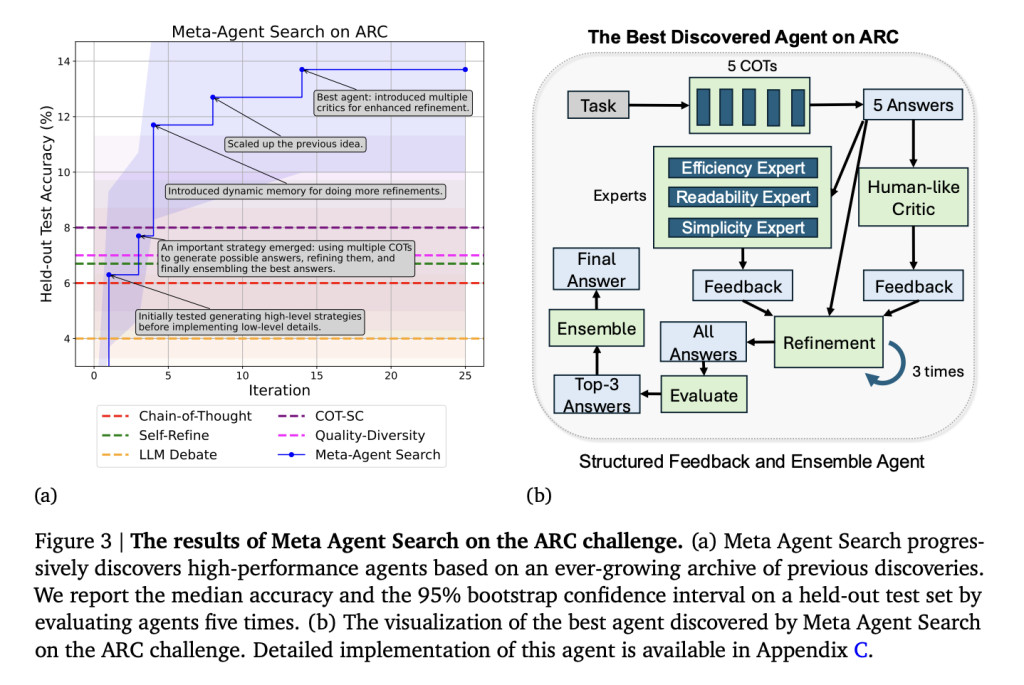Automated design in artificial intelligence (AI) is an emerging field focusing on developing systems capable of independently generating and optimizing their components. This approach is built on the premise that machine learning can surpass the limitations of manual design, enabling the creation of more efficient, adaptable, and powerful AI systems. The aim is to allow these systems to autonomously innovate, adapt, and solve increasingly complex tasks, particularly in environments that demand dynamic and flexible problem-solving abilities.
The core challenge in AI development is the significant manual effort required to design, configure, and fine-tune these systems for specific applications. As AI is applied to more complex and varied tasks, the demand for systems operating efficiently without extensive human intervention becomes critical. The problem is more than just the time and expertise needed; it is also about the inherent limitations of human-designed solutions. There is a growing recognition that automating the design process could lead to the discovery of novel and superior AI architectures that may need to be evident through traditional, human-centered approaches.
Traditionally, AI systems have relied on manual design methods, where researchers and engineers painstakingly develop and integrate components like prompts, control flows, and tools tailored for specific tasks. These methods, although successful, are inherently limited by the need for extensive human expertise and the time-consuming nature of the design process. Recent advancements in areas such as automated machine learning (AutoML) and AI-generating algorithms (AI-GAs) have alleviated these constraints by introducing some level of automation in the system design process. However, these methods often need to be expanded in scope, focusing primarily on specific components rather than the entire system architecture.
Researchers from the University of British Columbia, the Vector Institute, and Canada CIFAR AI Chair introduced a groundbreaking approach called Automated Design of Agentic Systems (ADAS). This method aims to fully automate the design of AI systems by employing a meta-agent that programs new agents in code. The ADAS approach is distinct in that it explores a vast search space of possible system configurations, enabling the discovery of more effective and efficient AI architectures without requiring manual intervention. The meta-agent iteratively creates, evaluates, and refines agentic systems, using an ever-growing archive of previous designs as a foundation for further innovation.
The ADAS method allows the meta-agent to program new agents based on a framework of simple yet essential functions, such as querying foundation models (FMs) or formatting prompts. The core idea is to instruct the meta-agent to iteratively create agents, test their performance on various tasks, and then use the results to inform subsequent iterations. This process encourages the meta-agent to explore novel and interesting designs, which are evaluated for effectiveness. ADAS can discover agentic systems that outperform state-of-the-art hand-designed agents across multiple domains through this iterative process.
The ADAS method has shown remarkable results. For instance, agents discovered by the ADAS algorithm improved F1 scores on reading comprehension tasks by 13.6 points and accuracy rates on math tasks by 14.4%. These agents also demonstrated impressive transferability, achieving accuracy improvements of 25.9% and 13.2% on math tasks when transferred across different domains. The ADAS-discovered agents maintained high performance even when applied to other models, such as GPT-4 and Claude-Sonnet, outperforming manually designed agents significantly. This robustness underscores the potential of ADAS to revolutionize the design and deployment of AI systems.
The ADAS approach represents a significant advancement in AI, offering a more efficient and potentially more innovative path to developing advanced agentic systems. By automating the discovery of effective AI components and architectures, ADAS reduces the reliance on manual design efforts and opens the door to creating more adaptable and efficient AI solutions. The method’s ability to discover generalizable design patterns and transfer them across different domains and models further highlights its potential to reshape the landscape of AI development.
In conclusion, the introduction of ADAS marks a pivotal moment in AI research, demonstrating that the full automation of AI system design is not only possible but also highly effective. The iterative process employed by the meta-agent allows for continuous innovation, leading to the discovery of agentic systems that surpass the capabilities of manually designed counterparts. As AI continues to evolve, methods like ADAS will be crucial in enabling the development of more powerful, efficient, and adaptable systems.
Check out the Paper, GitHub, and Project. All credit for this research goes to the researchers of this project. Also, don’t forget to follow us on Twitter and join our Telegram Channel and LinkedIn Group. If you like our work, you will love our newsletter..
Don’t Forget to join our 48k+ ML SubReddit
Find Upcoming AI Webinars here
The post Automated Design of Agentic Systems(ADAS): A New Research Problem that Aims to Invent Novel Building Blocks and Design Powerful Agentic Systems Automatically appeared first on MarkTechPost.
Source: Read MoreÂ

